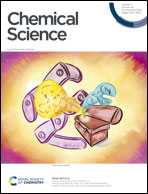Ruthenium-catalyzed cascade C–H activation/annulation of N-alkoxybenzamides: reaction development and mechanistic insight†
Abstract
A highly selective ruthenium-catalyzed C–H activation/annulation of alkyne-tethered N-alkoxybenzamides has been developed. In this reaction, diverse products from inverse annulation can be obtained in moderate to good yields with high functional group compatibility. Insightful experimental and theoretical studies indicate that the reaction to the inverse annulation follows the Ru(II)–Ru(IV)–Ru(II) pathway involving N–O bond cleavage prior to alkyne insertion. This is highly different compared to the conventional mechanism of transition metal-catalyzed C–H activation/annulation with alkynes, involving alkyne insertion prior to N–O bond cleavage. Via this pathway, the in situ generated acetic acid from the N–H/C–H activation step facilitates the N–O bond cleavage to give the Ru-nitrene species. Besides the conventional mechanism forming the products via standard annulation, an alternative and novel Ru(II)–Ru(IV)–Ru(II) mechanism featuring N–O cleavage preceding alkyne insertion has been proposed, affording a new understanding of transition metal-catalyzed C–H activation/annulation.



 Please wait while we load your content...
Please wait while we load your content...